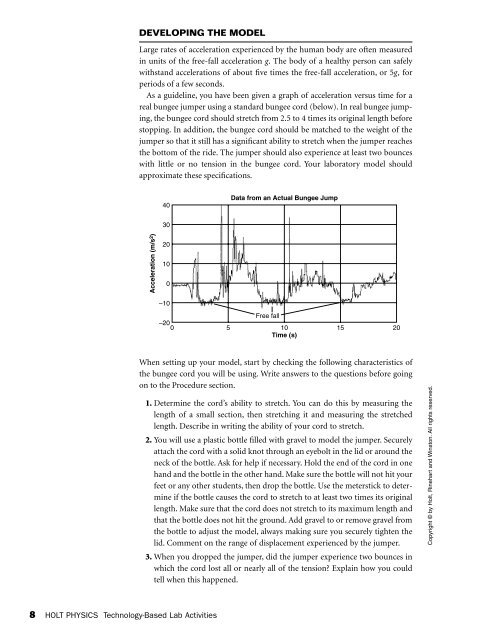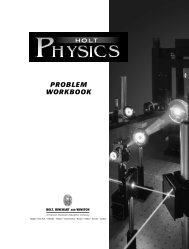TECHNOLOGY-BASED LAB ACTIVITIES
Lab Activities (PE).pdf - langlopress.net
Lab Activities (PE).pdf - langlopress.net
Create successful ePaper yourself
Turn your PDF publications into a flip-book with our unique Google optimized e-Paper software.
DEVELOPING THE MODEL<br />
Large rates of acceleration experienced by the human body are often measured<br />
in units of the free-fall acceleration g. The body of a healthy person can safely<br />
withstand accelerations of about five times the free-fall acceleration, or 5g, for<br />
periods of a few seconds.<br />
As a guideline, you have been given a graph of acceleration versus time for a<br />
real bungee jumper using a standard bungee cord (below). In real bungee jumping,<br />
the bungee cord should stretch from 2.5 to 4 times its original length before<br />
stopping. In addition, the bungee cord should be matched to the weight of the<br />
jumper so that it still has a significant ability to stretch when the jumper reaches<br />
the bottom of the ride. The jumper should also experience at least two bounces<br />
with little or no tension in the bungee cord. Your laboratory model should<br />
approximate these specifications.<br />
40<br />
Data from an Actual Bungee Jump<br />
30<br />
Acceleration (m/s 2 )<br />
20<br />
10<br />
0<br />
–10<br />
Free fall<br />
–20<br />
0 5 10 15 20<br />
Time (s)<br />
When setting up your model, start by checking the following characteristics of<br />
the bungee cord you will be using. Write answers to the questions before going<br />
on to the Procedure section.<br />
1. Determine the cord’s ability to stretch. You can do this by measuring the<br />
length of a small section, then stretching it and measuring the stretched<br />
length. Describe in writing the ability of your cord to stretch.<br />
2. You will use a plastic bottle filled with gravel to model the jumper. Securely<br />
attach the cord with a solid knot through an eyebolt in the lid or around the<br />
neck of the bottle. Ask for help if necessary. Hold the end of the cord in one<br />
hand and the bottle in the other hand. Make sure the bottle will not hit your<br />
feet or any other students, then drop the bottle. Use the meterstick to determine<br />
if the bottle causes the cord to stretch to at least two times its original<br />
length. Make sure that the cord does not stretch to its maximum length and<br />
that the bottle does not hit the ground. Add gravel to or remove gravel from<br />
the bottle to adjust the model, always making sure you securely tighten the<br />
lid. Comment on the range of displacement experienced by the jumper.<br />
3. When you dropped the jumper, did the jumper experience two bounces in<br />
which the cord lost all or nearly all of the tension? Explain how you could<br />
tell when this happened.<br />
Copyright © by Holt, Rinehart and Winston. All rights reserved.<br />
8 HOLT PHYSICS Technology-Based Lab Activities





